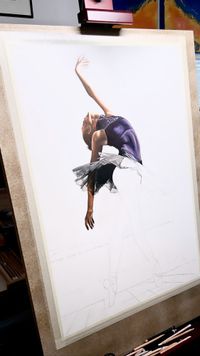colored pencils - farbstifte
"Colored pencils? Aren't only kids drawing with them...?"
Colored pencils are often ridiculed. Many people think of them more in terms of art lessons at school and children's drawings rather than works of art. They are a fairly new medium. Colored pencils, as they are used today, first appeared in the 1930s. At the beginning, visual artists hardly used them or only for sketching. This did not change until the first artists began to use colored pencils due to their versatility and expressiveness. Today they are considered a legitimate artistic tool.
Most artists use colored pencils in the hatching or shading technique. But there is another way: as the color application is partially transparent (semi-opaque), the colors can be built up in layers. High-quality colored pencils contain much more pigment than regular colored pencils and are therefore suitable for opaque color application, either by pressing on more firmly or by applying and mixing several layers of color in layers (burnishing).
Soft tonal gradations are created using the principle of optical color mixing. It is not possible to mix the colors directly, as is the case with watercolor, oil or acrylic paints, for example. Nevertheless, color transitions and applications are created that are so fluid and smooth that the result almost looks like an oil painting.
This medium has several other advantages: Highly pigmented oil or wax-based color pencils are long-lasting, as the colors do not dry out, as is the case with liquid media. The use of a fixative to preserve the pictures after completion is advisable, but unlike with pastel, charcoal and pencil, it is not absolutely necessary. Colored pencils are available in a variety of colors, which can usually be purchased individually. They can also be combined with other media such as pencil, ink, acrylic, gel pen, watercolor, pastel and gouache.
One disadvantage of the colored pencil drawing technique I use is that it is very difficult to correct mistakes. Erasers are practically powerless here. With the last layer, all the layers of color are worked into the paper texture with high pressure. After that, the color application cannot be completely removed. If you overdo it, you risk damaging the paper. In any case, the paper must be quite firm and heavy (>200 gsm) in order to survive the stresses and strains undamaged. The composition of a drawing must therefore be planned much more accurately than is necessary for a graphite or charcoal drawing.
. . . . . . . . . .
„Buntstifte? Damit malen doch nur Kinder…“
Farbstifte oder Buntstifte werden oft belächelt. Viele Menschen denken bei ihnen eher an den Kunstunterricht in der Schule und Kinderzeichnungen, statt an Kunstwerke. Sie sind ein eher junges Medium. Farbstifte, wie sie heute benutzt werden, kamen erst in den 1930er Jahren auf. Bildende Künstler nutzten sie anfangs kaum oder nur zum Skizzieren. Dies änderte sich erst, als die ersten Künstler begannen, Farbstifte aufgrund ihrer Vielseitigkeit und Ausdruckskraft zu verwenden. Heute gelten sie als legitimes künstlerisches Werkzeug.
Die meisten Künstler verwenden Buntstifte in der Schraffur- oder Schummertechnik. Es geht aber auch anders: Da der Farbauftrag teiltransparent (semi-opak) ist, können die Farben schichtweise aufgebaut werden. Hochwertige Künstlerfarbstifte enthalten viel mehr Pigmente als „normale“ Buntstifte und eignen sich daher für einen deckenden Farbauftrag, entweder durch festeres Andrücken oder durch schichtweises Auftragen und Mischen mehrerer Farb-schichten (Burnishing-Technik).
Weiche Tonabstufungen entstehen durch das Prinzip der optischen Farbmischung. Es ist zwar nicht möglich, die Farben direkt zu mischen, wie es z. B. bei Aquarell-, Öl- oder Acrylfarben der Fall ist. Dennoch entstehen Farbübergänge und Farbaufträge, die so fließend und glatt sind, dass das Ergebnis fast wie ein Ölgemälde aussieht.
Dieses Medium hat einige weitere Vorteile: Hochpigmentierte Künstlerfarbstifte auf Öl- oder Wachsbasis sind lange haltbar, da die Farben nicht austrocknen, wie man es von flüssigen Medien kennt. Die Verwendung eines Fixiermittels, um die Bilder nach der Fertigstellung zu konservieren, ist zwar ratsam, aber anders als bei Pastell, Kohle und Bleistift nicht unbedingt nötig.
Künstlerfarbstifte sind in einer Vielzahl von Farben erhältlich, die in der Regel einzeln nachgekauft werden können. Sie können auch mit anderen Medien wie Bleistift, Tusche, Acryl, Gelstift, Aquarell, Pastellkreide und Gouache kombiniert werden.
Ein Nachteil der von mir verwendeten Farbstift-Zeichentechnik: Es ist sehr schwierig, Fehler zu korrigieren. Radiergummis sind hier praktisch machtlos. Mit der letzten Schicht werden alle Farbschichten mit hohem Druck in die Papierstruktur eingearbeitet. Danach lässt sich der Farbauftrag nicht mehr restlos entfernen. Wer es übertreibt, riskiert das Papier zu zerstören. Dieses muss ohnehin relativ fest und schwer sein (>200 g/m²), um die Strapazen unbeschadet zu überstehen. Der Aufbau einer Zeichnung muss also viel genauer geplant werden, als es bei einer Bleistift- oder Kohlezeichnung notwendig ist.

